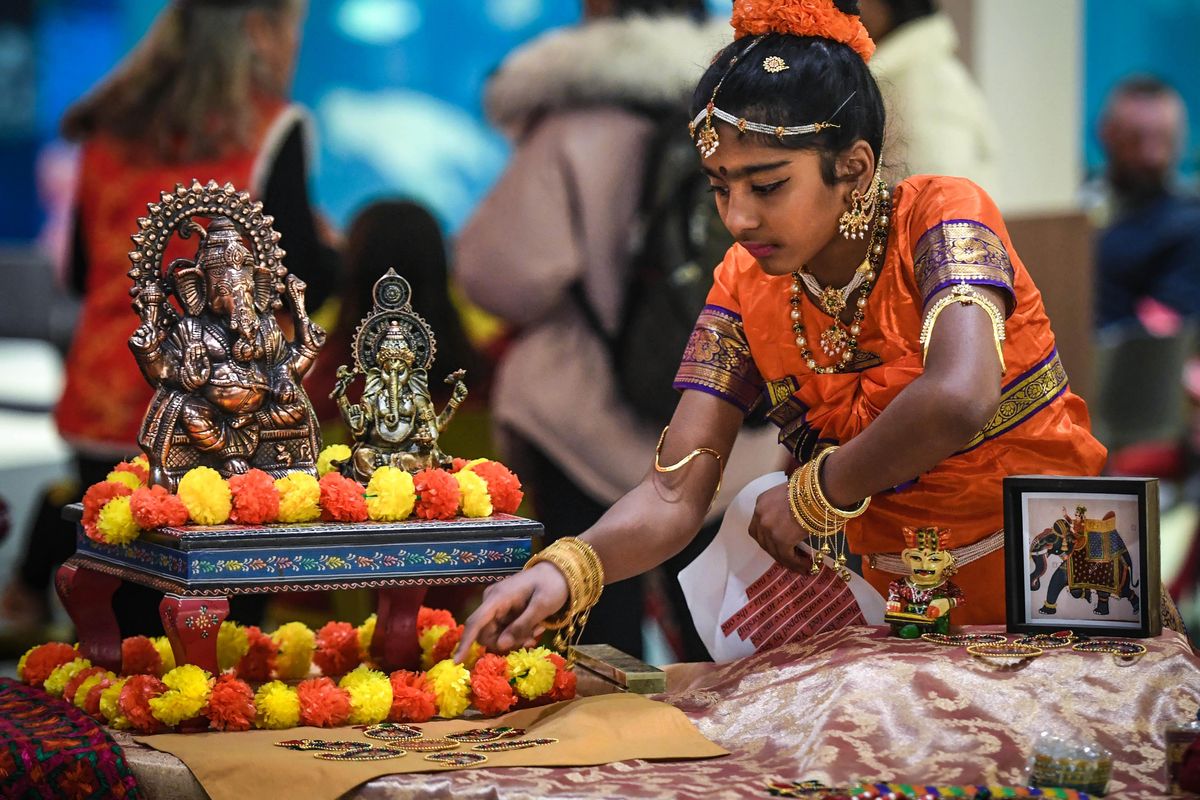Multicultural groups show Spokane how they ring in the new year at Northwest Winterfest

Charity Doyl grew up celebrating the holidays with traditions from a mix of four heritages.
“I’m German, Filipino, Indian and Spanish,” she said. “So my Christmas and New Year is usually a combination of the four cultures.”
Her background gave her the idea to start the month-long Northwest Winterfest last year, and she brought it back to NorthTown Mall this year with 25 different multicultural groups involved – an increase from 18 last year. She said when she reached out to family members from different cultures to take part, even more groups wanted to join.
“I thought it would be fun to bring the community together and have an intercultural exchange,” Doyl said.
On Saturday, the second to last day of Winterfest, multicultural groups, including Chinese, Indian, South Korean and Bulgarian, showed Spokane how they ring in a new year.

Chinese and South Korean traditions follow a lunar calendar and will celebrate the holiday on Jan. 25. And, depending on the region and religion, India holds New Year’s festivals from mid-spring to the late fall. Bulgaria falls in line with the Gregorian calendar – a new year on Jan. 1.
Emmy Hughes, who was helping with a Winterfest booth organized by local Chinese language and math teacher Ivy Hall, said it is customary to see red banners in households with Chinese characters, such as those that translate to “spring,” “good fortune” and “prosperity” in English. Those signs go on doors and in entryways as a symbol of arriving and things to come.
“You use red (banners) to bring good fortune,” Hughes said. “It is festive.”
Red envelopes filled with money as gifts from adults to children are also customary, Hughes said.
“Family comes together from all over in one place, and they eat a meal,” Hughes said. She added the meal is often followed by lighting fireworks and attending musical performances. “Mostly, it’s just gathering together with your loved ones.”
Several of Hall’s students dance and sang traditional songs for the people gathered Saturday at NorthTown Mall. The Spokane Chinese Association will host a traditional New Year’s celebration on Jan. 25 at University High School.
Minna Raudszus, a teacher at the Korean Language School in Spokane, said some traditional South Korean New Year’s customs are bowing to elders and parents, giving gifts of money and saying positive things about the future.
“The big thing about celebrating the new year is that you made it through another year,” said Raudszus, adding that it was significant for her to survive her childhood in South Korea.
Students from the school performed dances from K-pop songs, which have found a burgeoning audience in the U.S. and around the world in the last several years.
“K-pop is a big part of Korean culture,” Raudszus said. “That is the one way we can let the world know we exist since our country is so small.”
Mentors and mentees from the Indian Youth Club, which was started this August, shared traditional Indian food and recipes with people at the mall while talking about other aspects of Indian culture. New Year’s celebrations vary by religion and region based on whether they follow the solar or lunar calendar.
Two of the most celebrated fall in the autumn and the spring. Diwali, the festival of lights, marks the beginning of a new year in some traditions and was celebrated at the end of October this year. It emphasized prosperity, health and happiness.
And Navaratri, a nine-day festival in the spring, begins with a celebration of the strength, sacrifices, responsibilities and love of women around the world.
“All the things that a woman embodies,” said Vaishali Rajeev, an Indian Youth Club mentor.
Diana Osborne, a Bulgarian immigrant, demonstrated the tradition she grew up with of children slapping adults on the back with a decorated stick called a Survaknitza to ward off bad fortune and health and reciting a poem wishing for prosperity and good luck.
Osborne said children start with their parents and make their way around their neighborhoods and to other relatives, then come home with a bag of treats they collect.
Osborne and Alisa Vashon both wore traditional Bulgarian clothing while talking about the traditions they grew up with. Vashon and her family had a booth at Winterfest the past two years.
Another Bulgarian New Year’s tradition is baking bread with a coin and pieces of dogwood to signify good luck and prosperity.
“The kids are really looking for the coin,” Osborne said.
Bulgaria also celebrates a number of different days around the holidays named after different saints.
“It is a time of constant celebration,” Osborne said. “You just go from household to household visiting family.”